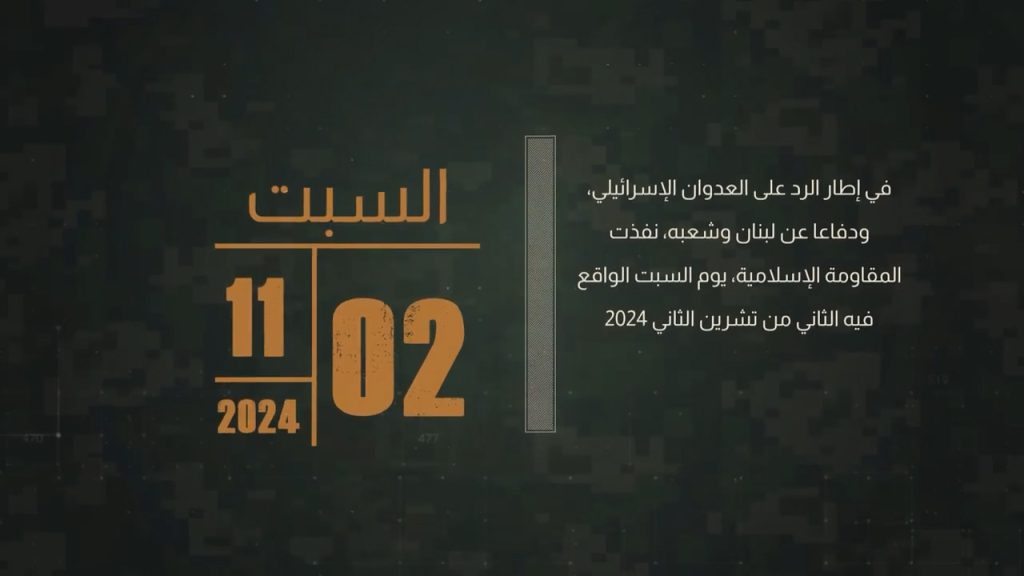Recalling the 2024 war log, Hezbollah’s Military Media on Friday unveiled new details from the thirty-second day of the Israeli offensive against Lebanon. During this phase, Resistance fighters intensified their ground and cross-border operations, marking significant advances amid the ongoing Israeli assault.
These revelations form part of the “Formidable in Might” documentary series—an episodic production by Hezbollah’s Military Media that chronicles the daily progression of the conflict.
More than a simple chronicle, the series serves as a historical testament to endurance and sacrifice, portraying the stories of men who, through their blood and resilience, inscribed enduring chapters of valor in the annals of the resistance.
Marking the thirty-second day of the war, Hezbollah’s Military Media also outlined the Islamic Resistance’s operations conducted on Saturday, November 02, 2025.
In response to ongoing Israeli aggression and in defense of Lebanon and its people, the Islamic Resistance carried out 26 military operations on Saturday, November 2, 2024. The attacks targeted Israeli settlements, military outposts, barracks, and troop gatherings along the Lebanon–Palestine border, using rockets and artillery fire.
Direct Clashes on the Border
According to the group’s statement, an Israeli armored unit attempted to advance toward the Lebanese border town of Hula but was detected by Hezbollah fighters. Skilled anti-tank units fired two guided missiles, destroying and igniting two military bulldozers at the front of the force, killing and wounding several Zionist soldiers, and forcing the unit to retreat toward Al-Khazzan Hill on Houla’s outskirts. The retreating troops were then hit by three additional rocket salvos, reportedly causing direct hits.
Rocket Attacks on Northern Israeli Bases
Hezbollah’s rocket units also launched salvos of missiles targeting several Israeli military bases, settlements, and cities in northern occupied Palestine, including Zevulun Military Industries Base, north of Haifa, the occupied city of Safed; Elta Military Industries Company, northeast of Haifa and Snot Gin Base, north of Acre.
The regional logistics regiment of the Israeli occupation’s Northern Command at Misgav Base northeast of Haifa was targeted for the first time.
As part of Operation “Khaybar,” Hezbollah’s rocket force struck both the Glilot Base of the Israeli Military Intelligence Unit 8200 near the occupied city of Tel Aviv and the Zvulun Industrial Base near Haifa with volleys of precision missiles.
Drone Strikes Deep Inside occupied Palestine
Hezbollah’s air unit also launched drone assaults using swarms of explosive UAVs against the Glilot Base, near ‘Tel Aviv’; Shraga Base, the administrative headquarters of the Golani Brigade; and north of Acre.
Ramat David Air Base and its adjacent military airport.
Palmachim Air Base, one of the Israeli Air Force’s primary installations, is located about 140 km south of the Lebanon–Palestine border, near Tel Aviv.
Israeli media outlets reported that air-raid alerts lasted more than 30 minutes as the drones penetrated deep into northern Israel, reaching the vicinity of Ramat David. Attack helicopters and fighter jets were scrambled in response.
The Israeli military confirmed detecting three to four drones that crossed from Lebanon and exploded at multiple sites, including a factory in Akziv in western Galilee and another location in the Jezreel Valley. The Ziv Medical Center in occupied Safed said it had received ten wounded Israeli soldiers from clashes with Hezbollah forces.
Throughout the day, air-raid sirens sounded 28 times across occupied Palestine, particularly in Upper Galilee settlements, from Ras Al-Naqoura in the north down to the Tel Aviv area in the south, marking one of the most extensive alerts since the recent escalation began.




